General aim
I am trying to write some plotting functionality that (at its core) plots arbitrary paths with a constant width given in data coordinates (i.e. unlike lines in matplotlib which have widths given in display coordinates).
Previous solutions
This answer achieves
the basic goal. However, this answer converts between display and data
coordinates and then uses a matplotlib line with adjusted
coordinates. The existing functionality in my code that I would like
to replace / extend inherits from matplotlib.patches.Polygon. Since
the rest of the code base makes extensive use of
matplotlib.patches.Polygon attributes and methods, I would like to
continue to inherit from that class.
Problem
My current implementation (code below) seems to come close. However,
the patch created by simple_test seems to be subtly thicker towards
the centre than it is at the start and end point, and I have no
explanation why that may be the case.
I suspect that the problem lies in the computation of the orthogonal vector.
As supporting evidence, I would like to point to the start and end points of the patch in the figure created by complicated_test, which do not seem exactly orthogonal to the path. However, the dot product of the orthonormal vector and the tangent vector is always zero, so I am not sure that what is going on here.
Code
#!/usr/bin/env python
import numpy as np
import matplotlib.patches
import matplotlib.pyplot as plt
class CurvedPatch(matplotlib.patches.Polygon):
def __init__(self, path, width, *args, **kwargs):
vertices = self.get_vertices(path, width)
matplotlib.patches.Polygon.__init__(self, list(map(tuple, vertices)),
closed=True,
*args, **kwargs)
def get_vertices(self, path, width):
left = _get_parallel_path(path, -width/2)
right = _get_parallel_path(path, width/2)
full = np.concatenate([left, right[::-1]])
return full
def _get_parallel_path(path, delta):
# initialise output
offset = np.zeros_like(path)
# use the previous and the following point to
# determine the tangent at each point in the path;
for ii in range(1, len(path)-1):
offset[ii] += _get_shift(path[ii-1], path[ii+1], delta)
# handle start and end points
offset[0] = _get_shift(path[0], path[1], delta)
offset[-1] = _get_shift(path[-2], path[-1], delta)
return path + offset
def _get_shift(p1, p2, delta):
# unpack coordinates
x1, y1 = p1
x2, y2 = p2
# get orthogonal unit vector;
# adapted from https://stackoverflow.com/a/16890776/2912349
v = np.r_[x2-x1, y2-y1] # vector between points
v = v / np.linalg.norm(v) # unit vector
w = np.r_[-v[1], v[0]] # orthogonal vector
w = w / np.linalg.norm(w) # orthogonal unit vector
# check that vectors are indeed orthogonal
assert np.isclose(np.dot(v, w), 0.)
# rescale unit vector
dx, dy = delta * w
return dx, dy
def simple_test():
x = np.linspace(-1, 1, 1000)
y = np.sqrt(1. - x**2)
path = np.c_[x, y]
curve = CurvedPatch(path, 0.1, facecolor='red', alpha=0.5)
fig, ax = plt.subplots(1,1)
ax.add_artist(curve)
ax.plot(x, y) # plot path for reference
plt.show()
def complicated_test():
random_points = np.random.rand(10, 2)
# Adapted from https://stackoverflow.com/a/35007804/2912349
import scipy.interpolate as si
def scipy_bspline(cv, n=100, degree=3, periodic=False):
""" Calculate n samples on a bspline
cv : Array ov control vertices
n : Number of samples to return
degree: Curve degree
periodic: True - Curve is closed
"""
cv = np.asarray(cv)
count = cv.shape[0]
# Closed curve
if periodic:
kv = np.arange(-degree,count+degree+1)
factor, fraction = divmod(count+degree+1, count)
cv = np.roll(np.concatenate((cv,) * factor + (cv[:fraction],)),-1,axis=0)
degree = np.clip(degree,1,degree)
# Opened curve
else:
degree = np.clip(degree,1,count-1)
kv = np.clip(np.arange(count+degree+1)-degree,0,count-degree)
# Return samples
max_param = count - (degree * (1-periodic))
spl = si.BSpline(kv, cv, degree)
return spl(np.linspace(0,max_param,n))
x, y = scipy_bspline(random_points, n=1000).T
path = np.c_[x, y]
curve = CurvedPatch(path, 0.1, facecolor='red', alpha=0.5)
fig, ax = plt.subplots(1,1)
ax.add_artist(curve)
ax.plot(x, y) # plot path for reference
plt.show()
if __name__ == '__main__':
plt.ion()
simple_test()
complicated_test()

